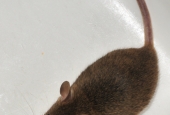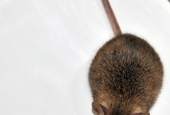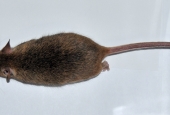Mice have keen senses of taste, hearing, smell, and touch. They are excellent climbers and can run up any rough vertical surface. Mice can squeeze through openings slightly larger than ¼ inch across and can jump up to 12 inches from the floor. House mice frequently find their way into homes in the fall when outdoor temperatures at night become colder. Their nests are often made from fine shredded paper or other fibrous material, usually in sheltered locations. Mice are active mostly at night, but sometimes they will be seen during daylight hours.
In a single year, a female may have 5 to 10 litters of about 5 or 6 young. Young are born 19 to 21 days after mating, and they reach reproductive maturity in 6 to 10 weeks. The life span of a mouse is usually 9 to 12 months.
Wooden snap traps are effective and can be purchased in most hardware stores. Traps can be baited with a variety of foods; peanut butter is the most popular because it is easy to use and attractive to mice and other rodents. There are a number of different types of traps on the market with varying methods of capture. Trap placement technique is important. Traps should be placed wherever there is evidence of mouse activity and checked frequently. Place them close to walls so mice will pass directly over the trigger. Glue traps can be used but are less effective than snap traps. More traps often leads to greater success.
Sanitation and storing food stuffs and pet foods in rodent proof containers will help reduce any food sources for mice. However, for a long term solution, exclusion is necessary. Inspect the exterior of the structure for any ¼” or larger openings and seal. Seal cracks and openings along the foundations and around openings for water pipes, vents, and utility cables with wire mesh, metal flashing, concrete or similar material. Install quality door sweeps on exterior doors. Remove wood piles and other storage along foundation and remove or trim vegetation away from the structure. On the interior, seal mouse entry openings and remove all mouse droppings. This will make future re-infestations easier to detect.
Finding all potential mouse entry points can be difficult. Call our District or submit an online request for an inspection and assessment.
Download the complete Brochure here






